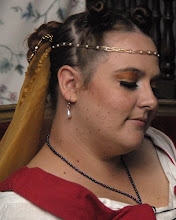



** part 2 of category ***food in your area, including what was available, where it came from, restrictions on food and how it would be prepared. You shall include a sample of a menu for a normal day and for a feast
A Sixteenth Century Dinner (normal day)
First Course
Brawn (boar meat)
Roast Beef
Roast Venison (deer)
Meat Pie
Vegetables in season
Bread
Second Course
Roast Lamb
Rabbit
Bread
Tarts and Custard
The staple diet consisted of meat and bread and was much sweeter than today's food. Manchet was a very fine white bread made from wheat flour with a little bran and wheat germ added. It was creamy-yellow in colour. This bread was for the nobility
a wide variety of meat and game including what they hunted:- deer, boar, rabbit, quail, bustard, curlew, plover, cormorant, badger, hedgehog, heron, crane, pheasant, woodcock, partridge, blackbirds, etc. They also had meat from the animals they reared on their land:- beef, mutton, veal, lamb, kid, pork, rabbit, chicken, duck, swan, peacock, goose, pigeon, doves etc.
The sea fish for eating included cod, haddock, ling, conger, and plaice.The fresh water fish included eels, pike, perch, trout, sturgeon, roach, and salmon.Cockles, mussels and oysters
Nobility didn't eat a lot of vegetables some medical texts advise against eating raw vegetables as engendering wind (gas) or evil humours. A variety of vegetables grown included leeks, garlic, peas, parsnips, collards, kale lentils, turnips, broad beans, onions, spinach, carrots, beets, artichokes, radishes, and asparagus. Herbs included borage, sage, thyme, rosemary, parsley and chives. edible flowers were also commonly seen in dishes
There were many varieties of apples, pears and cherries grown in England. Other popular fruits included damsons, plums, strawberries and gooseberries. Most of the fruit was cooked as doctors thought that raw food caused illness. Oranges, limes or any fruit imported from abroad was expensive and therefore only eaten by the upper classes. "Apricocks" (apricots) were imported from Portugal and "apples of love" (tomatoes) came from Mexico.
Sweets were common. Sugar became very popular and England was known for it's high quality honey. At Court sugar was added to ale, sauces for meat and fish, and sweetmeats like "marchpane" (marzipan).
Everyone avoided drinking water because it was very polluted. Hypocras was a sweet liqueur imported from the Eastern Mediterranean; it was the most expensive drink of all and was served at Royal banquets and special occasions. Wine was popular at Court; Sack was a sherry, a sweet wine from Spain; Aqua vitae (the Latin for the water of Life) was the name given to any strong spirit such as brandy. Ale was the word used for any fermented drink made from grain and water at Court more ale was drunk than wine. Small Ale (newly brewed) was often drunk at morning meals.
Feast
First Remove:
Soup (2 varieties, vegetable & meat)
Second Remove:
Roast peacock
Pork & egg pies
Roast Tongue
Leg of Pork
Fried spiced onions
Roast root vegetables
Beans
Third Remove:
Mushroom pasties
Braised venison in pepper sauce
Roast Lamb
Rabbit
Tarts and Custard
Bread
Fourth Remove:
Pears in red wine
Cheese and fruits
Marchpanes
candied roses and violets
cakes
wafers
Bibliography
Hart, R (1972) English Life in Tudor Times, Wayland Publishers, LondonEmmison, F.G. (1964)
Tudor Food and Pastimes - Life at Ingatestone Hall, Ernest Benn Ltd, LondonFraser, A (1996)
The Six Wives of Henry VIII, Weidenfeld & Nicolson, LondonDyer, C (1989)
Standards of Living in the Later Middle Ages, Cambridge University Press, CambridgeBlack, M (1992)
The Medieval Cookbook, British Museum Press, LondonRenfrow, C (1998)
Take a Thousand Eggs or More, Volume 2, Cindy Renfrow

No comments:
Post a Comment